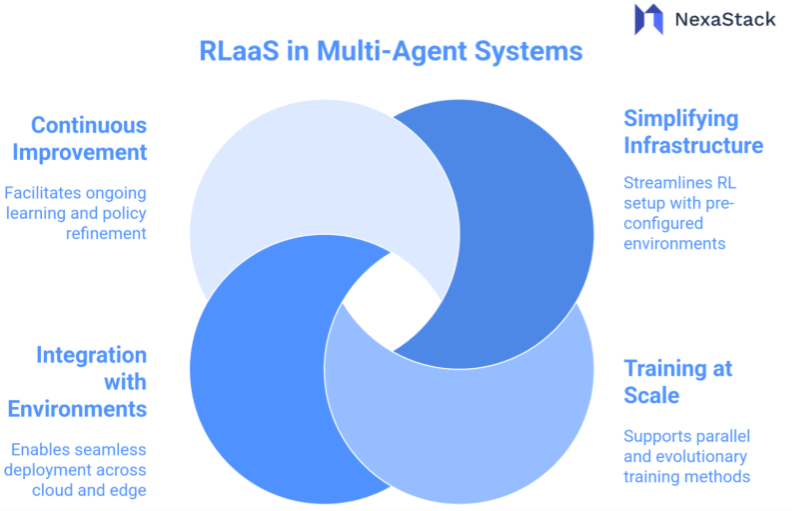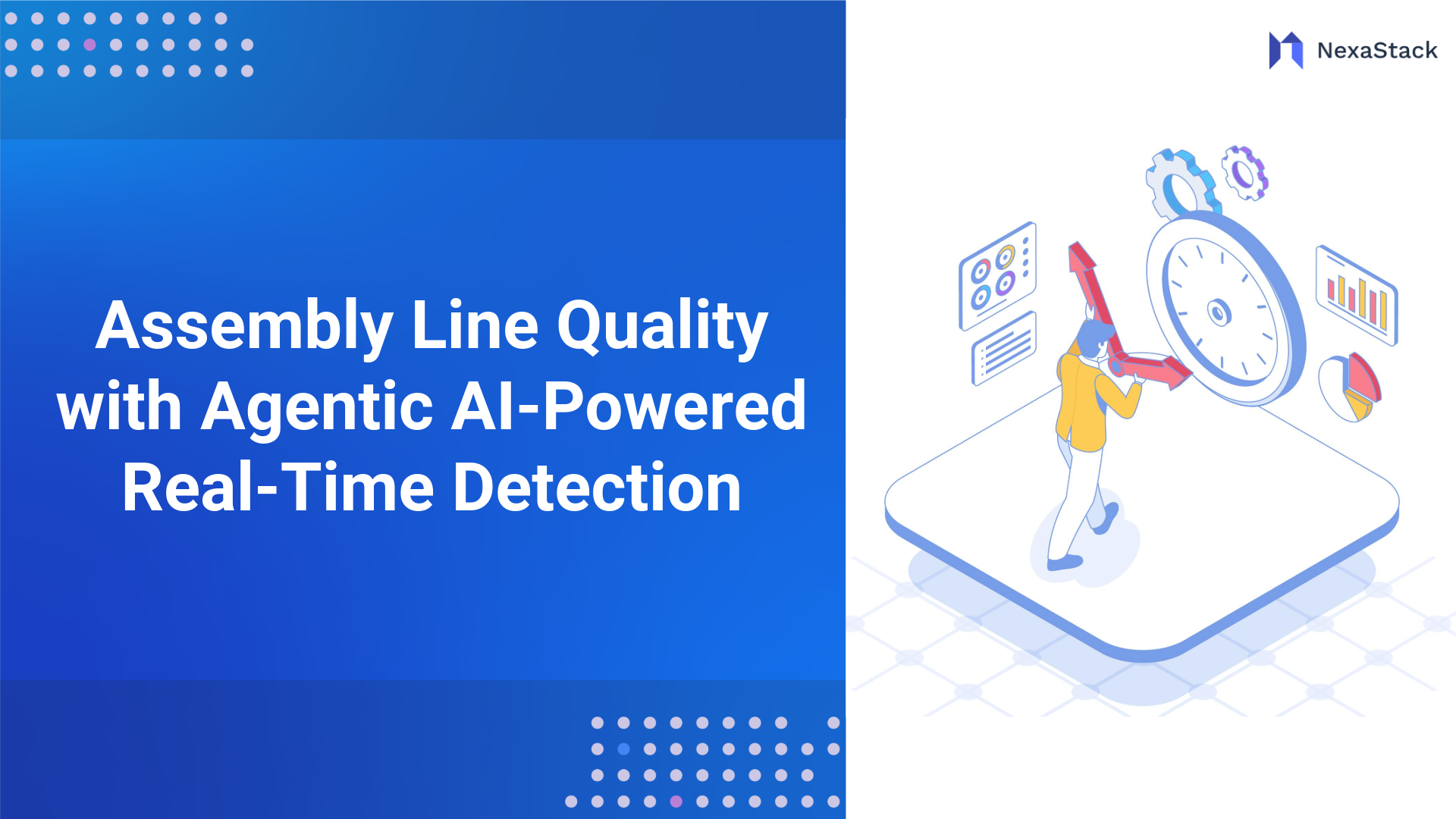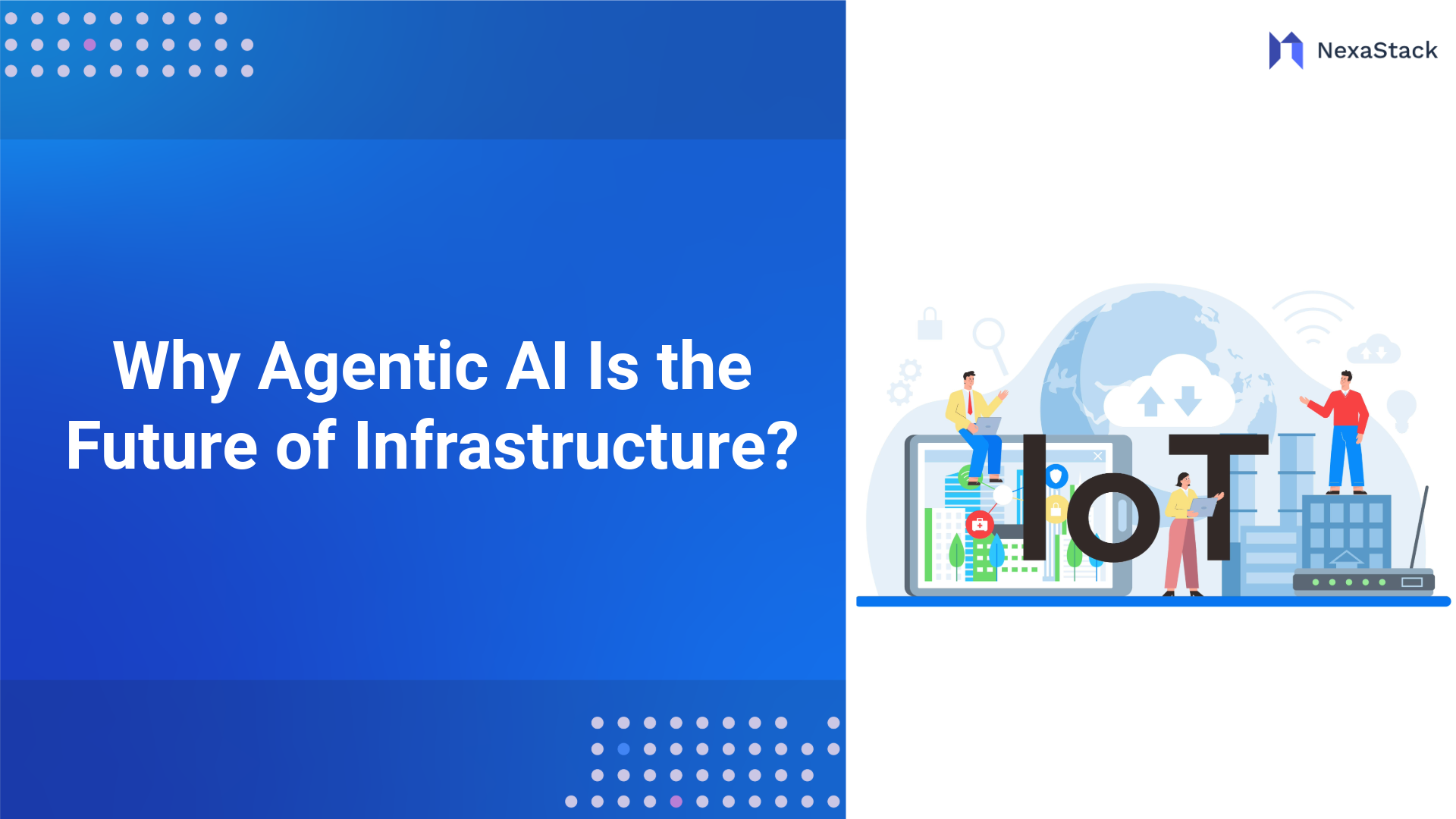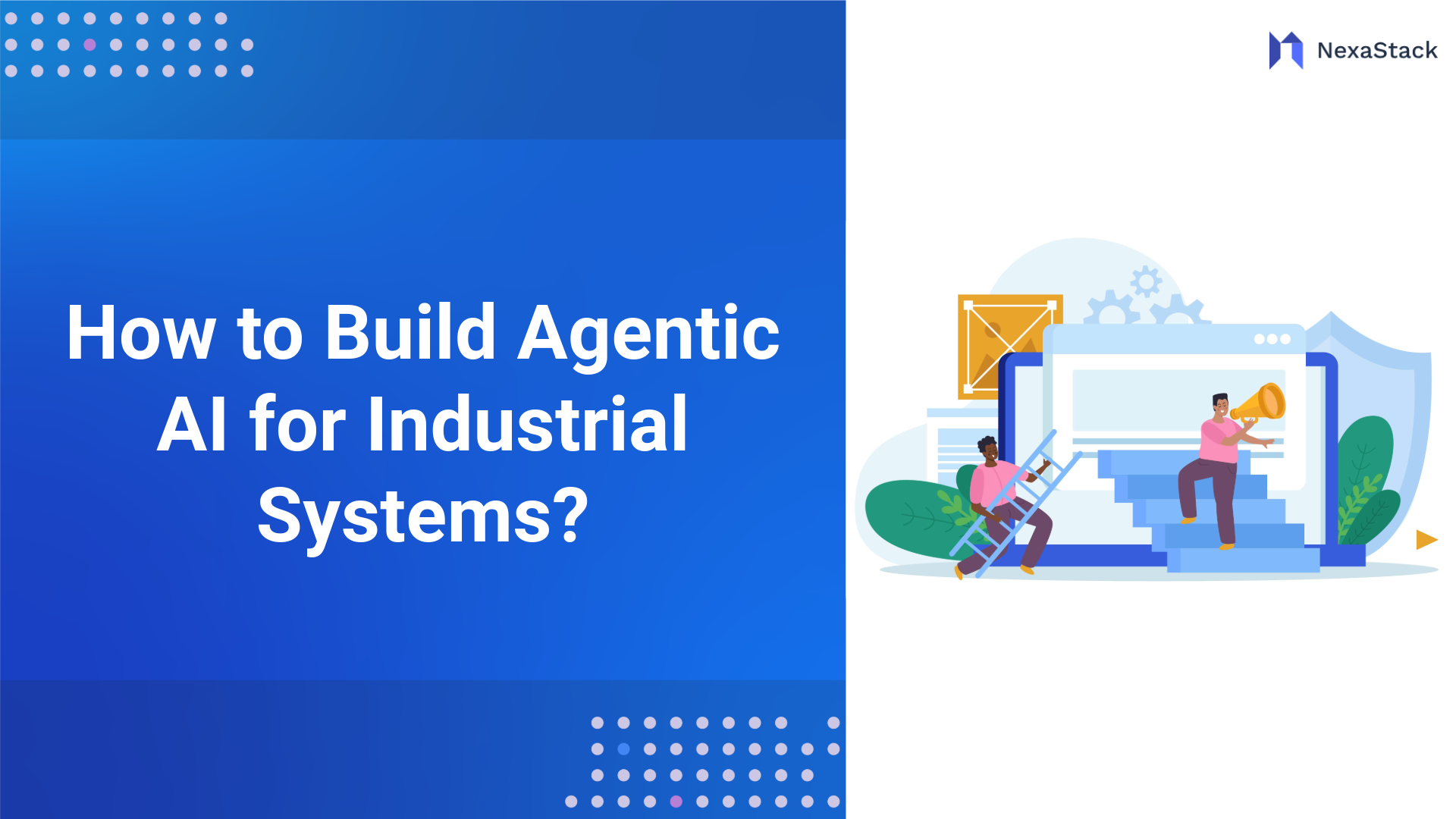Designing and deploying multi-agent AI systems requires a deep understanding of coordination, scalability, and continuous optimization. As enterprises move toward autonomous operations, the challenge lies not just in building individual agents but in orchestrating them effectively to achieve shared goals. This is where Nexastack provides a critical advantage — offering a Context-First Agent Infrastructure that enables seamless collaboration, observability, and control across distributed AI ecosystems.
Through Reinforcement Learning as a Service (RLaaS) and AgentOps, organizations can develop adaptive, goal-driven agents that learn from real-world feedback and continually improve their decision-making. RLaaS allows developers to train and fine-tune agents in simulated or live environments. At the same time, AgentOps on Nexastack ensures operational reliability through monitoring, evaluation, and automated governance of multi-agent systems. Together, these capabilities enable enterprises to transition from reactive automation to proactive intelligence — where agents autonomously manage workflows, optimize resources, and enhance system performance.
By leveraging Nexastack’s unified orchestration and observability layers, teams gain full visibility into agent interactions, behavior outcomes, and performance metrics. This integration empowers businesses to architect scalable and secure agentic systems that align with enterprise objectives. Whether it’s coordinating autonomous workflows, managing digital twins, or optimizing infrastructure, Nexastack provides the foundation for building and governing next-generation AI ecosystems with confidence.
In this blog, we’ll explore how RLaaS and AgentOps streamline the development, deployment, and management of multi-agent AI architectures, transforming the way intelligent systems collaborate and evolve.
What Are Multi-Agent AI Systems
A multi-agent system (MAS) is a collection of autonomous entities, known as agents, that operate in a shared environment. Each agent can perceive, make decisions, and act; however, the real power lies in their interactions with one another.
Core characteristics of agents:
-
Autonomy: They operate without constant human oversight.
-
Social ability: They communicate and coordinate with peers.
-
Reactivity: They respond to changes in their environment.
-
Proactivity: They pursue goals rather than just reacting.
These systems mirror natural ecosystems—like ant colonies, bird flocks, or human markets—where complex group behaviors emerge from simple local interactions. In AI, MAS can be designed to collaborate (e.g., swarm robotics), compete (e.g., trading bots), or combine both approaches.
Why Reinforcement Learning (RL) and AgentOps Are Critical
Reinforcement Learning for Multi-Agent Systems
Reinforcement Learning is ideal for agents operating in dynamic environments. Agents learn policies—rules for choosing actions—by trial and error, receiving rewards for good outcomes.
In multi-agent settings, RL enables:
-
Cooperation: Agents learn to share resources or synchronize actions.
-
Competition: Agents develop adversarial strategies in markets or games.
-
Adaptation: Policies evolve as environments or peer strategies change.
The Role of AgentOps
But learning policies isn’t enough. Once deployed, agents must be continuously managed, monitored, and optimized to ensure optimal performance. This is where AgentOps comes in:
-
Tracking decisions and behaviors.
-
Detecting anomalies or drifts.
-
Automating retraining and scaling.
-
Ensuring governance and compliance.
Together, RL (via RLaaS) and AgentOps ensure not only intelligent agents but also sustainable ecosystems of agents that can be trusted to operate reliably in production.
From Single-Agent AI to Multi-Agent Collaboration
In the early days, AI solved narrow problems: a chess engine, a spam filter, a speech recognizer. However, complex domains—such as logistics, finance, or climate modeling—require multiple subproblems to be solved simultaneously and often in collaboration.
For example:
-
A single autonomous car can navigate streets, but an entire fleet must coordinate routes, negotiate intersections, and avoid traffic jams.
-
A single cybersecurity bot can patch a vulnerability, but multiple defense agents are needed to detect attacks, isolate compromised nodes, and neutralize threats.
This leap from single-agent to multi-agent systems introduces new design principles:
-
Communication protocols for coordination.
-
Shared goals or incentive structures for cooperation.
-
Conflict resolution strategies for competition.

Key Challenges in Building Multi-Agent AI Systems
- Coordination and Communication: Without coordination, agents may work at cross-purposes. Messaging layers (e.g., gRPC, MQTT) and consensus protocols ensure agents can exchange state updates, negotiate, or reach group decisions.
Example: In smart grids, power-balancing agents must agree in seconds to prevent blackouts. - Real-Time Decision-Making: Domains like autonomous driving require little margin for delay. Agents must use lightweight inference, cache decisions, and fail gracefully if uncertainty is high.
Example: A drone swarm avoiding mid-air collisions cannot wait for cloud-based updates; edge inference is critical. - Scalability Across Environments: Agents can be deployed across heterogeneous infrastructures, including cloud data centers, factory floors, and IoT devices. Ensuring consistency, load balancing, and interoperability is a complex task.
-
Monitoring and Lifecycle Management: Debugging MAS is notoriously difficult because emergent group behaviors are unpredictable. Without monitoring, it’s hard to tell whether outcomes are due to policy flaws, communication bottlenecks, or environmental noise.

Fig 2: Key Challenges in Multi-Agent AI Systems
Role of RLaaS in Multi-Agent Systems
Simplifying RL Infrastructure
Reinforcement learning is resource-intensive—requiring simulations, distributed training, and experiment tracking. RLaaS abstracts away this complexity with APIs and managed infrastructure.
Training Multi-Agent Models at Scale
RLaaS enables:
-
Parallel training on thousands of simulated agents.
-
Self-play, where agents learn by competing with themselves.
-
Curriculum learning that gradually increases task difficulty.
-
Population-based training where weaker policies evolve into stronger ones.
Example: OpenAI Five (Dota 2 agents) utilized massive parallel training to master teamwork against human opponents. RLaaS makes such scale accessible beyond research labs.
Cloud, Edge, and Hybrid Integration
RLaaS enables training on powerful cloud servers, followed by exporting compact policies to edge devices for real-time inference. Federated RL ensures local data stays private while global models improve.
Continuous Improvement
Agents aren’t static. RLaaS integrates with pipelines that:
-
Collect telemetry from real-world runs.
-
Retrain or fine-tune policies automatically.
-
Deploy updated versions through CI/CD workflows.

What is AgentOps and Why It Matters
Defining AgentOps
AgentOps extends MLOps into the domain of interactive, autonomous agents. It provides the operational discipline needed for multi-agent systems to thrive in production.
Core Functions:
-
Monitoring: Capture logs, decisions, and outcomes to detect anomalies or explain failures.
-
Orchestration: Schedule tasks, manage communication flows, and dynamically scale agents.
-
Optimization: Fine-tune policies, balance workloads, and enforce system-wide KPIs.
Comparing AgentOps to MLOps
MLOps manages passive models, such as a fraud detection classifier, which take input, produce predictions, and are occasionally retrained. AgentOps, by contrast, manages active, decision-making agents that continuously interact with dynamic environments and with each other.
Key distinctions include:
-
Agent Registries: Track agent roles, capabilities, states, and dependencies for dynamic orchestration and management.
-
Multi-Agent Debugging Tools: Trace interactions, detect conflicts, and analyze emergent behaviors.
-
Collective Performance Metrics: Evaluate coordination efficiency, resource utilization, and overall system behavior, rather than just individual outcomes.
-
Dynamic Lifecycle Management: Automate updates, health checks, anomaly detection, and safe policy rollouts.
In short, while MLOps handles static models, AgentOps enables the development of reliable, adaptive, and scalable multi-agent systems.
Architectural Blueprint for Multi-Agent AI Systems
- Communication and Orchestration Layer
Acts as the nervous system. Provides messaging backbones (WebSockets, gRPC, MQTT), service discovery, task allocation, and consensus mechanisms.
- RLaaS for Training and Policy Updates
Manages centralized or federated training, policy version control, and support for specialized algorithms like MADDPG or MAPPO.
- Inference and Action Pipelines
Optimized for speed and safety. Supports edge inference, hardware accelerators (TPUs, GPUs), caching, and redundancy mechanisms.
- Observability and Governance
Dashboards show agent health, decision traces, compliance logs, and anomaly alerts. Ensures trust in agent behavior. 
Best Practices for Architecting Multi-Agent AI
-
Design Modular Agents: Use reusable components for perception, decision, and action.
-
Leverage RLaaS: Rely on managed infrastructure for scalable training and simulation.
-
Implement AgentOps Early: Monitoring and governance must be built in from the start.
-
Prioritize Latency: Edge-first inference for real-time domains.
-
Harden Security: Encrypt channels, authenticate agents, and log all decisions for audits.
Industrial Use Cases
Smart Manufacturing
Robotic arms coordinate with sensors for assembly, predictive maintenance, and defect detection. RLaaS provides simulation training; AgentOps ensures safe deployment and retraining.
Autonomous Transportation
Drones and vehicles collaborate on delivery, fleet routing, and air traffic management. RLaaS simulates traffic chaos, while AgentOps manages updates and ensures compliance.
Energy Grid Optimization
Microgrid agents forecast demand, balance supply, and adapt to renewable sources. RLaaS trains allocation policies; AgentOps enforces reliability and regulatory compliance.
Financial Markets
Trading bots coordinate strategies while competing for profits. RLaaS accelerates experimentation; AgentOps monitors risks and ensures regulatory compliance.
Cybersecurity
AI defense agents act like immune systems: scanning logs, detecting anomalies, and isolating threats. RLaaS trains them in adversarial simulations; AgentOps ensures explainability and resilience.
Deployment Strategies for RLaaS + AgentOps
- Cloud-Native : Kubernetes clusters manage agent lifecycles. Microservices architecture ensures modular scaling. Observability stacks provide metrics and tracing.
- Hybrid and Edge-Enabled : Edge devices run lightweight agents for low-latency decisions while syncing with the cloud for updates.
- CI/CD for RL Models: Automated retraining and canary deployments reduce risk when rolling out new policies.
- Automated Updates with AgentOps: Policies are continuously monitored, with retraining triggered by drift or anomalies.

Future of Multi-Agent AI
-
Digital Twins and IoT
Every physical asset could have a digital twin agent. Combined with IoT, these agents simulate, predict, and optimize real-world operations.
-
Self-Learning Agent Collectives
Agents may one day exchange knowledge peer-to-peer, forming collective intelligence without centralized training.
-
AI Governance and Ethics
Ethical issues grow as agents make more decisions autonomously. AgentOps will embed explainability, conduct fairness audits, and ensure compliance with regulations such as the EU AI Act.
-
Next-Gen Accelerators
Specialized silicon (e.g., neuromorphic chips, RL-specific accelerators) will enable ultra-low-latency learning and inference at the edge.
Case Studies
Case Study 1: Drone Delivery Network
A logistics company deployed a swarm of delivery drones. RLaaS trained them in obstacle-rich simulations (weather, no-fly zones, unexpected traffic). AgentOps handled deployment, including monitoring airspace compliance, dynamically updating routes, and scaling operations across cities.
Case Study 2: Smart Factory Automation
In an automotive plant, welding robots, conveyor sensors, and inspection cameras formed a MAS. RLaaS trained predictive maintenance policies, while AgentOps detected drifts in sensor reliability and automatically retrained agents—resulting in an 18% reduction in downtime.
Case Study 3: Cyber Defense as a Service
A cloud provider built AI-powered cybersecurity with multiple defense agents—log analyzers, anomaly detectors, and response coordinators. RLaaS trained them against simulated attack vectors. AgentOps ensured auditability, allowing the provider to prove compliance during regulatory reviews.
Conclusion of Using RLaaS and AgentOps
Multi-agent AI systems represent a leap in how intelligence is designed and deployed. Instead of single models, we now build ecosystems of agents that collaborate and compete in real time. RLaaS provides the training foundation, while AgentOps ensures safe, reliable, and explainable operation.
As industries—from logistics to finance—adopt this paradigm, success depends not just on more intelligent agents but also on stronger infrastructure, governance, and continuous improvement. Looking forward, digital twins, self-learning collectives, and next-gen accelerators will transform MAS from cutting-edge experiments into the backbone of tomorrow’s AI-driven world.
Next Steps With Multi-Agent AI Systems
Talk to our experts about implementing compound AI system, How Industries and different departments use Agentic Workflows and Decision Intelligence to Become Decision Centric. Utilizes AI to automate and optimize IT support and operations, improving efficiency and responsiveness.


